11. Implications and applications¶
Research & Concept¶
Previous experimentation¶
I have had this idea in my head for quite some time now. Two years ago, i bought a polarized light educational science kit and started playing around with it. The kit comes with 2 polarized filters and various translucent materials to observe. One of the materials that was interesting to look at was cellulose acetate, which changes color when you rotate it, bend it, fold it. I started to ask myself what can i do to transform this material and create novel visual effects.
I experimented with various techniques but slicing quickly became my focus because it provided the most interesting results. After slicing roughly by hand i started to use a laser cutter to cut out various precise cutting patterns and experiment with this.
At the time I was in my portland studio, using an overhead projector and projecting these effects onto the wall. I thought this could be really interesting projections for a music show and it could be interactive, inviting the audiance members to experiment with the materials and create their own projections. I haven't made an effort to make this idea a reality yet, but I might someday.
Life got busy and i ended up putting the filters away in a drawer, but they remained in the back of my mind. I brought them back out every once in a while when i had something new to observe, but didn't really do anything with them. But slowly, in my mind, i started to imagine what it would be like to blend this with my fashion design background. I started to imagine shoes and clothes made of these translucent materials that transform when observed with the polarized filters.
References & Inspiration¶
"Distance" reclaimed by umbrellas on a rainy day¶
One of the first examples i found of polarized filters being used in the art world was "Distance" Reclaimed by Umbrellas on a Rainy Day by Kotoro Watanabe. I was immediately stunned by the beauty of the image but also the story. Tororo Watanabe explains that they redesigned the umbrella as an object that brings people closer together as opposed to an object that creates space around the user.

CHROMA¶
I also found this very impressive work by artist Yunchul Kim who uses light, motors and polymers to create mesmerizing kinetic sculpture. He doesn't talk about how these effects are achieved but i am 99% certain it involves the use of polarizing filters.
It seems polarized light is a recurring element of his work, and understandibly because it is really captivating to look at.
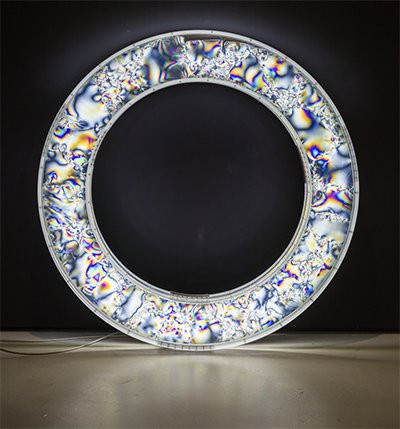
Polarization¶
Switzerland based artist Pelang explores the use of polarized filters in his series of kinetic sculptures called polarization. Pelan doesn't take advantage of the color effects that can be created with polarizers, rather he uses the filters to modulate light and achieve varying shades of black. With the use of rotation enabled by motors, he's able to create a very dynamic visual.
Animal senses¶
I looked into scientific papers that investigate polarization and found a very interesting paper on cephalopods. The scientists have observed that cephalopods create polarized reflections on their skin and are wondering if this mechanism allows them to communicate with other cephalopods. Polarized light is not detected by every species, so only polarization sensitive creatures would be able to see these reflective patterns. This allows the cephalopods to create hidden communication paths.
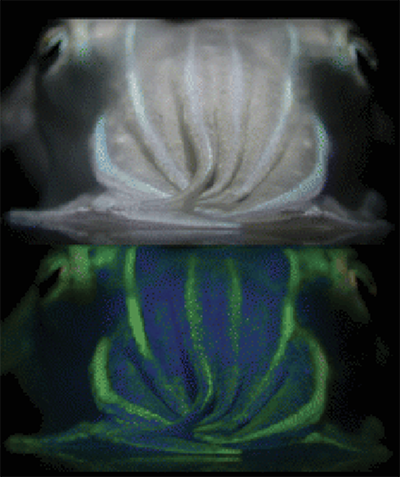
I also found another article titled Secret Communication Channels in the Ocean: Polarization Vision where the author Justin Marshall explains how more and more scientists are discovering that many creatures might have highly tuned polarization vision.
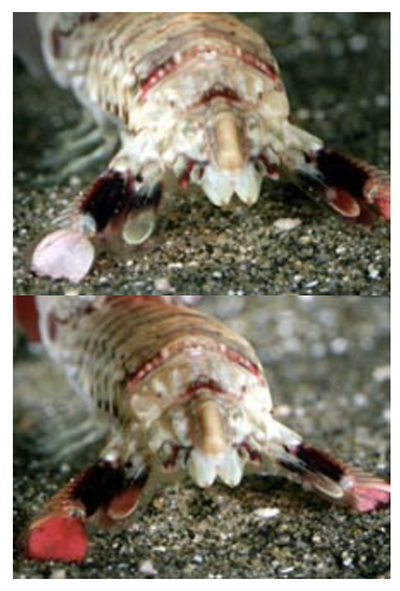
This also makes me reflect on how different animal perception is compared to ours. Certain animals have evolved special senses that we don't have. I am wondering if the use of the polarized filters is a way of exploring this sense that only a few creatures have, polarization vision?
Spy tech & information encoding¶
The concept of hidden communication lead me to find this tutorial in Make magazine. The author shows how to create hidden messages that can only be seen while wearing sunglasses. I am becoming a little bit obsessed with this ability to hide and reveal something.
I also found this Research paper in Advanced Materials on inducing birefringence in 3D printed objects. Birefringence is the optical property of a material having a refractive index that depends on the polarization and propagation direction of light. This is the property that will make a material reveal colors when viewed between crossed polarizers.

This team of scientists are programming the birefringence of a 3D printed material by controling the speed of the print. As the extruder prints faster, the filament gets stretched and that creates birefringence. Using this technique, they can conceal information into the material. This is also a really cool notion to think about, the idea of being able to program a specific message.
Amazing world of insect wing discovered¶
I also find inspiration in this article in wired on the discovery of a colorful world hidden in insect wings. The author doesn't talk about the use of polarizers, but rather the discovery of the right viewing and lighting conditions, specifically using a black background allowed them to see a whole world of color that was previously unnoticed.
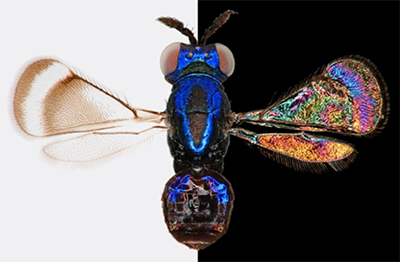
The case of the colorblind painter¶
Some more poetic inspiration comes in the form of a short story by Oliver Sacks: The case of the colorblind painter. This is one of my favorite short stories by the author, where he follows one of his patients who is a painter who became colorblind following an automobile accident. As an artist painter, losing the ability to see color was a devastating experience and he talks about how the world is horrible to look at now. But he eventually adapts, as most people do, and starts to see the world from a different perspective.
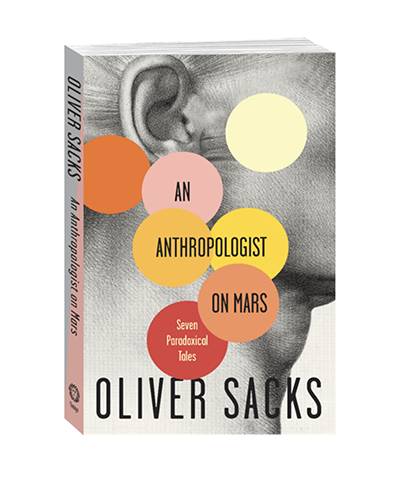
This is a quote from the book that encapsulates what i love about this story:
Although Mr. I. does not deny his loss, and at some level still mourns it, he has come to feel that his vision has become “highly refined,” “privileged,” that he sees a world of pure form, uncluttered by color. Subtle textures and patterns, normally obscured for the rest of us because of their embedding in color, now stand out for him. He feels he has been given “a whole new world,” which the rest of us, distracted by color, are insensitive to. He no longer thinks of color, pines for it, grieves its loss. He has almost come to see his achromatopsia as a strange gift, one that has ushered him into a new state of sensibility and being.
Apart from being an incredible story of how adaptable the human brain is, it makes me reflect on the duality of the monochrome and the colorful. Is color distracting us from seeing the beauty of pure form? Is the monochrome realm full of subtle beauty?
It also makes me think of, again, perception and how different people or creatures perceive the world.
Project proposal: (mono)chrome¶
(mono)chrome aims to explore the different possibilities for color revealing and concealing in a fashion context, enabled by polarizing filters.
Why?
- To push the boundaries of fashion with a cross-disciplinary approach.
- To advance my design practice to a new place, by incorporating color and lack of color at the center of the process. In the past, i have found color to be a distraction and have chosen to focus on form and think of color last. When i use colors, i use it parsimoniously and as an afterthought. This exploration would mark a departure from this and bring color at the center, while still enjoying the subtle beauty of a monochrome design.
- To explore the possibility of design for polarization.
How?
- I plan on exploring bioplastics and analyzing them using cross-polarized filters to uncover their hidden, colorful patterns.

- I plan on utilizing computational design to explore form dynamically, utilizing, for example, computationally driven cuts in the material to reveal color where stress occurs.
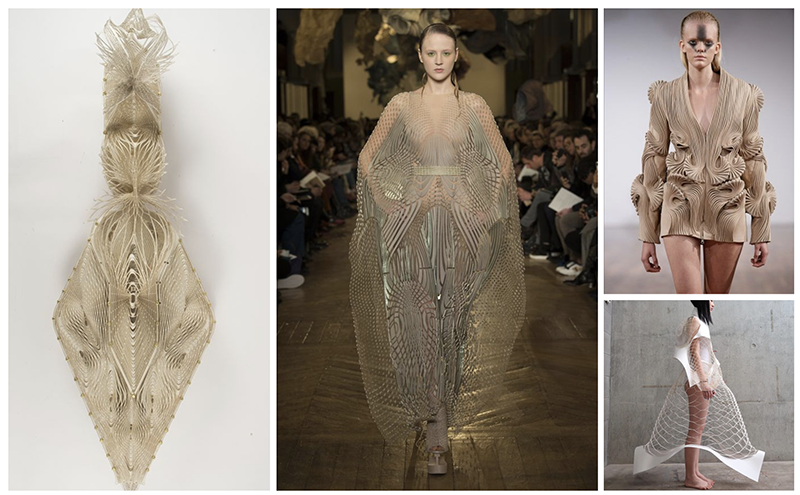
- I plan to explore the possibility of incorporating soft robotics to introduce dynamic movement and organic forms, drawing inspiration from the flexibility of soft-bodied water creatures.

Slide show¶
Embed your presentation